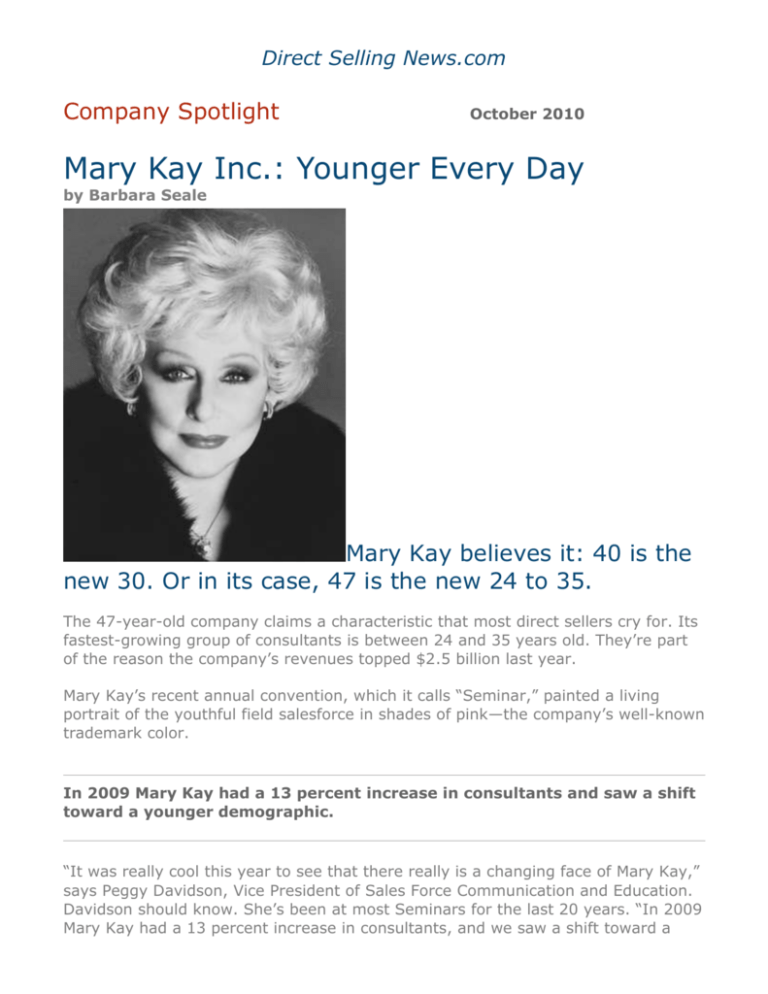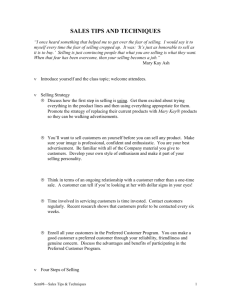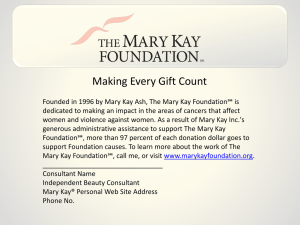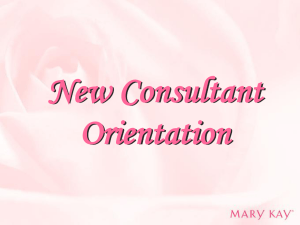Direct Selling News.com
advertisement

Direct Selling News.com Company Spotlight October 2010 Mary Kay Inc.: Younger Every Day by Barbara Seale Mary Kay believes it: 40 is the new 30. Or in its case, 47 is the new 24 to 35. The 47-year-old company claims a characteristic that most direct sellers cry for. Its fastest-growing group of consultants is between 24 and 35 years old. They’re part of the reason the company’s revenues topped $2.5 billion last year. Mary Kay’s recent annual convention, which it calls “Seminar,” painted a living portrait of the youthful field salesforce in shades of pink—the company’s well-known trademark color. In 2009 Mary Kay had a 13 percent increase in consultants and saw a shift toward a younger demographic. “It was really cool this year to see that there really is a changing face of Mary Kay,” says Peggy Davidson, Vice President of Sales Force Communication and Education. Davidson should know. She’s been at most Seminars for the last 20 years. “In 2009 Mary Kay had a 13 percent increase in consultants, and we saw a shift toward a younger demographic. Our average age is now 36 years old, and the largest number of people coming into Mary Kay in the U.S. are 24 to 35 years old. It was exciting to look out over the audience and see how many where there from the younger demographic and how much there is to offer them—and to all ages, of course—in direct selling and especially in Mary Kay.” Cultured Crowd The Seminar let Mary Kay recognize, educate and motivate its salesforce—times five. Because of its size, the company actually holds five duplicate three-day events over a two-and-a-half-week period each year. Some 30,000 consultants attend. It’s one of the highlights of the year. Not only do executives introduce new products and greet thousands of consultants face to face, but they also demonstrate the renowned Mary Kay culture, including a strong dose of hands-on philanthropy. “We built our ninth Habitat for Humanity house right during Seminar,” Davidson says. “Salesforce members worked out there in the July Texas heat and built a house for a woman whose life course has now changed because she has a home for her family. What an incredible feeling!” Seminar attendees also brought gently used suits to donate to five domestic violence shelters for women job seekers living in the shelters. The suits allow them to dress professionally for job interviews. Independent beauty consultants at the Seminar also reached into their purses and donated $364,000 in cold, hard cash to The Mary Kay Foundation. The company’s focus on philanthropy is one of many company characteristics that attract and retain both independent beauty consultants and employees to Mary Kay. Davidson says it’s especially important to younger independent beauty consultants. It complements other tools, technology and products that appeal to women of every age, and especially to younger consultants. “Technology is part of it, along with social marketing,” she says. “We’re active on Facebook for Mary Kay and The Mary Kay Foundation. Our website is incredible. It includes fun tools like model makeovers that help us be seen in a more current light. And our career plan is a great one. People getting out of college want more than their mothers went through. My generation accepted the daily grind. This generation doesn’t. Our culture, what we do for others, along with the fun of what they’re selling—those are all things this generation is very tuned into.” Mary Kay’s 200 products are a big, pink plus, too. Sheryl Adkins-Green, Vice President of Brand Development, notices that color cosmetics often provide a beautiful introduction to the whole portfolio of cosmetics and skincare products. “Having products, shades, packaging and forms that the younger generation wants to touch and experiment with is very important,” she says. “While a more experienced cosmetics buyer may already have favorites, everyone in the salesforce was equally excited about our fall collection. Women want to try things that are exciting, to try things that enhance their beauty and help them achieve their beauty goals. They’re looking for new sensations, and we want to provide that in our products.” Giving’s Up Though Economy’s Down Mary Kay Ash believed that when you think big, you achieve big things. The foundation that carries her name proved that tough times don’t have to limit the help you can provide to others if you dream big. 2009 was a record-setting year, and 2010 looks just as bright. The mission of The Mary Kay Foundation is bold: To eliminate cancers affecting women and to end the epidemic of violence against women. Last year it directed $5.8 million in support of its key programs. Since its inception, The Mary Kay Foundation has donated $25 million to programs addressing domestic violence and nearly $15 million to cancer research. The day that Mary Kay executives spoke to Direct Selling News, they were choosing 150 domestic violence shelters that would each receive $20,000 grants for a total donation of $3 million. The Mary Kay Foundation directed $5.8 million in support of its key programs. Mary Kay Inc. supports The Mary Kay Foundation’s efforts to the tune of $2 million every year and by offering special products that support its causes. For example, its line of Beauty that Counts® creme lipsticks carry color names like Compassion, Inspiration and Confidence. Their sales support the Mary Kay Foundation’s efforts to end domestic violence. Mary Kay Inc. donates $1 from each sale of the limitededition lipsticks. Customers and independent beauty consultants sometimes buy them in multiples so they can support the cause while getting a great lipstick. Independent beauty consultants also get into the act by holding and participating in special events they organize themselves. The foundation even provides guidelines for events that include 5K walk/runs, fashion shows and special benefit nights with sports teams. The guidelines provide a complete template that helps consultants succeed in organizing the events. “There isn’t a woman out there who hasn’t suffered through breast, ovarian or uterine cancer, or who knows someone who has,” says Peggy Davidson, Mary Kay’s Vice President of Sales Force Communication and Education. “We give them a vehicle for doing what’s in their hearts.” Since it was established in 1996, the foundation’s philanthropy has grown steadily. In 1997 its donations were $500,000. By 2004, they had reached $3.6 million. It accomplishes its goals through direct donations, product sales and events led by its army of more than 2 million independent beauty consultants. Here are some of the Mary Kay Foundation’s highlights last year: Granted 150 domestic violence shelters $20,000 each—a total of $3 million Awarded 13 respected doctors and medical scientists $100,000 each in cancer research grants—a total of $1.3 million Donated $500,000 to CancerCare Inc., a nonprofit organization dedicated to providing free professional help to people with cancer, for its Touching Hearts program Contributed $300,000 to the National Network to End Domestic Violence, with $200,000 earmarked to support the Amy’s Courage Fund, which provides assistance to victims of domestic violence and their children $200,000 to the Arbor Day Foundation for Nature Explore Classrooms at five domestic violence shelters across the United States Raised $136,957 in the Team Up For Women! Challenge Raised $378,110 from donations at Seminar 2009 Raised more than $76,700 in sponsorships in the 5th annual MK5K® Mary Kay independent salesforce members lend a hand to help build the companies 9th Habitat for Humanity home during Mary Kay’s annual Seminar. International Insights She notes that the beauty market around the world has more commonalities than differences. Mary Kay now does business in more than 35 countries—Armenia is the most recent—and while women in some regions focus more on skin care while women in others enjoy experimenting with color, it’s all a matter of degree. In Asia, for example, women focus on skin care. In Latin America and parts of Europe, color cosmetics and fragrances take a lead role. Women everywhere from Delhi to Des Moines can shop the web for the styles and products that matter most to them. The Internet allows beauty information to race around the world as quickly as you can click a computer mouse. “Because beauty news travels instantly over the Internet, we find that women around the world are eager to try many of the same things,” Adkins-Green says. “One of the benefits Mary Kay has as a global organization is that we can tap into trends from all over the world. It’s a great opportunity to have our fingers on the pulse of beauty trends and practices from around the world.” The company’s international presence lets it gain consumer insights, quickly adapt, and incorporate the latest beauty and skin-health technology into its products. But the beautiful bottom line is this: Women like to look their best. “Women love to be pampered, and we love to try new things, but for the most part we want to look like ourselves, only better,” she says. “That gets expressed in different words around the world. Some people love to glam it up, and we have fun helping them do that. But many Mary Kay women like how they look and just want to hold onto that. That’s why our TimeWise® [anti-aging] line is so popular.” Adkins-Green says that one of the challenges she is enjoying at Mary Kay is finding solutions to beauty needs through Mary Kay products and leveraging them around the world so that the company’s products resonate with women around the globe and gain a sustainable following. “It’s a challenge, but it’s helped Mary Kay be successful,” she says. “We’re able to peel the onion, get down to our consumers’ core needs and develop highperforming products that satisfy those needs year after year.” Customer Commitment When Adkins-Green joined Mary Kay about a year and a half ago, she brought a wealth of experience, but no direct selling experience. She quickly developed an appreciation for the unique commitment the company has to its customers. “Many organizations talk about being customer focused and putting their customers first. I don’t think they can speak to that credibly until they have been inside a world-class direct selling organization like Mary Kay,” she says. “We put our independent beauty consultants and their customer base first in all decisions. If I contrast that to my previous experience in businesses with retail outlets, the dimensions of customer loyalty are very different.” She embraces the stark difference between retail sales and direct selling that industry veterans have long appreciated: Relationships are everything. “Relationships between the company and its independent salesforce and relationships with the salesforce and their customer base are all lasting relationships that are very valuable,” she says. “When you know that you are going to live with your business decisions for a long time, you think about them in a different way. It’s not about the quick promotions to help the company hit their quarterly numbers. It’s not about a flash of brilliance that will get you a promotion. You need to take a long-term perspective. This role is more challenging strategically for that reason. There are no shortcuts.” That long-term view is as much a part of the Mary Kay culture as its commitments to customer-pleasing products and philanthropy. It started almost half a century ago when recently retired Mary Kay Ash began outlining a book designed to help women survive in the male-dominated business world. Working at her kitchen table, she developed two lists. One featured the good things she had seen in the companies where she had worked; the other contained the things she thought could be improved. She must have flushed a pretty pink as she realized that she had created a plan for a “dream company.” Working with her 20-year-old son Richard Rogers, she used her $5,000 life savings to make that dream come true. She started a company that offered women unprecedented opportunities for financial independence, advancement and personal fulfillment—concepts the company now captures in its tagline: Enriching Women’s Lives®. She chose cosmetics as the product that would help women help each other succeed and grow. Her company became renowned for its culture, its international success and its brand, and she became a direct selling industry icon. Although she died on Thanksgiving Day, 2001, Mary Kay Ash still influences the company’s executives, employees and salesforce every day. Mary Kay Inc. became renowned for its culture, its international success and its brand. Global Consistency Culture, consistency and brand awareness are key criteria for Mary Kay. The company goes to great lengths to ensure that its culture is the same in India or Indiana. Dedicated teams of employees known as the Culture Committee work together to deliver training and guidelines that are globally constant. The Golden Rule—treat others as you want to be treated—was Mary Kay Ash’s mantra, and it continues to be the company culture’s backbone today. Products are equally consistent, including their top-quality ingredients, their packaging and the brand they carry. The company created brand tool kits that are used worldwide to ensure the consistency of the Mary Kay brand. And operational consistency is just as important. No matter where in the world Mary Kay does business, it ensures the caring culture, product quality and outstanding opportunity that its consultants and customers have come to expect. When Adkins-Green joined the company, she noticed it right away. “Coming in new to the organization and going through the process of learning about the company’s strengths relative to our goals, I think Mary Kay has done a great job,” she says. “I worked on consumer packaged goods with Cadbury Schweppes, Kraft Foods and others. When I came to Mary Kay and saw the resources the company is devoting to the business, such as supply chain opportunities that it leverages to accelerate speed-to-market, I was impressed.” As Mary Kay approaches its 50th anniversary, executives look forward to ways to make it even more successful. As Mary Kay approaches its 50th anniversary, executives look forward to ways to make it even more successful. Financial goals, market expansion and new products are all part of the plans. But most important is the company’s continuing focus on providing women with an opportunity that lets them meet any goal they’re willing to work toward, whether the goal is additional income or financial independence. “We’ll continue to look at different types of tools that the salesforce can use that provide them with constantly up-to-date technology, education on the go, social media. We’ll make sure that we continue to support them by creating pride in their company, as well as a viable opportunity,” Davidson says. But she and AdkinsGreen both say that when company executives talk about the tactics that will fuel the company’s future success, they’re really talking about one thing: Providing an opportunity for women to make their lives better. Adkins-Green says enthusiastically, “How exciting it is to be part of an organization that has successfully remained relevant by being focused on values and mission. When I look around at the challenges that other industries have faced and contrast them to the success and trust that Mary Kay has built, it’s great to see how, with a strong vision and leadership at the top, a company can maintain its relevance for such a long time and for many years to come.” As Green As It Is Pink Mary Kay Inc. CEO David Holl (2nd from left) leads a tree planting with Dallas civic leaders and the Arbor Day Foundation as a part of the company’s Pink Doing Green CSR initiative. Mary Kay was green before green was cool. Always thinking long term, Mary Kay executives know that the company’s actions today will affect the quality of life for generations to come, so they continually look for ways to be even more sustainable and environmentally responsible. From planting trees in Montana, Dallas, Monterrey, Shanghai, Hangzhou and Ningxia to refilling and recycling compacts, to reducing and recycling waste in its manufacturing facilities, the company’s commitment to a clean environment is constant. Mary Kay calls it Pink Doing Green®. And it’s no newcomer to sustainability. Since 1989 Mary Kay has had an extensive recycling program that now includes product line packaging, paper, plastic, corrugated cardboard, ink cartridges, old cell phones and aluminum. Distribution centers ship orders using packing materials made from renewable corn and potato starch “biopeanuts,” which are completely biodegradable. Product carton inserts are made with a minimum of 20 percent recycled content, and the company has reduced its energy consumption globally by almost 13 percent—enough energy to power more than 1,100 average homes for a year. And while its environmental stewardship isn’t intended to garner awards, it has. As long ago as 1993, Mary Kay received the first Fashion and Environmental Award from the United Nations Environmental Program. It also has been recognized by the U.S. Environmental Protection Agency, Keep America Beautiful, and the American Lung Association. In 2007 Mary Kay China was awarded the Model Unit of Environment Protection by the Environment Protection Bureau of the Hangzhou Economic and Development Area. For Mary Kay, sustainability is just another expression of The Golden Rule. “Part of our culture is responsibility for the world we live in and the city we live in,” says Peggy Davidson, Vice President of Sales Force Communication and Education. “From the beginning Mary Kay Ash had a passion for doing for others. It’s just part of our responsibility.”





